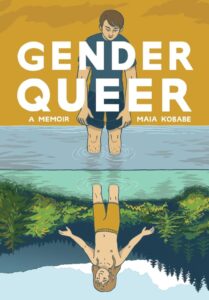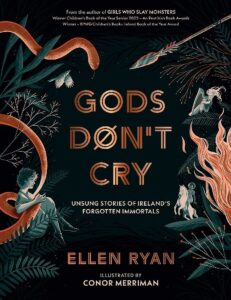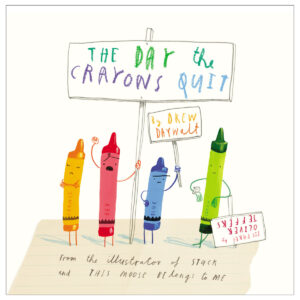Gender Diversity in Fiction
By Sam Carpenter, Teen Librarian
 It’s April! Along with warmer temperatures and summer growing closer comes Little Apple Pride. This year Pride will take place starting at 11:30 am Saturday, April 12, 2025 in City Park. The public library will be there as well. Be sure to look for our table. We will have stickers, buttons, and smiling faces galore.
It’s April! Along with warmer temperatures and summer growing closer comes Little Apple Pride. This year Pride will take place starting at 11:30 am Saturday, April 12, 2025 in City Park. The public library will be there as well. Be sure to look for our table. We will have stickers, buttons, and smiling faces galore.
This year, I want to bring focus to books in our collection that have diverse gender representation. There are records of gender nonconforming individuals, according to Ianna Urquhart in “Exploring the History of Gender Expression,” an article written for the University of California Gender Pronoun Initiative, going back as early as the Copper Age. Many cultures have words for these people from the Native American two-spirit to the Hindi Hijra. Here are some of my favorites.
Adult Fiction
“Gender Queer: A Graphic Novel: A Memoir” written and illustrated by Maia Kobabe.
“Maia’s intensely cathartic autobiography charts eir journey of self-identity, which includes the mortification and confusion of adolescent crushes, grappling with how to come out to family and society, bonding with friends, and facing the trauma and fundamental violation of pap smears. Started as a way to explain to eir family what it means to be nonbinary and asexual, ‘Gender Queer’ is more than a personal story: it is a useful and touching guide on gender identity–what it means and how to think about it–for advocates, friends, and humans everywhere.”
“The Pairing” by Casey McQuiston.
“Theo and Kit have been a lot of things: childhood best friends, crushes, in love, and now estranged exes. After a brutal breakup on the transatlantic flight to their dream European food and wine tour, they exited each other’s lives once and for all. All that remains is the unused voucher for the European tour that never happened, good for 48 months after its original date and about to expire. Four years later it’s not until they board the tour bus that they discover they’ve both accidentally had the exact same idea, and now they’re trapped with each other for three weeks of stunning views, luscious flavors, and the most romantic cities of France, Spain, and Italy. It’s fine. There’s nothing left between them. So much nothing that, when Theo suggests a friendly wager to see who can sleep with their hot Italian tour guide first, Kit is totally game. And why stop there? Why not a full-on European hookup competition? But sometimes a taste of everything only makes you crave what you can’t have.”
Young Adult Fiction
“Icarus” by K. Ancrum.
“Icarus Gallagher is a thief. He steals priceless art and replaces it with his father’s impeccable forgeries. For years, one man–the wealthy Mr. Black–has been their target in revenge for his role in the death of Icarus’s mother. To keep their secret, Icarus adheres to his own strict rules to keep people, and feelings, at bay: Don’t let anyone close. Don’t let anyone touch you. And, above all, don’t get caught. Until one night, he does. Not by Mr. Black but by his mysterious son, Helios, now living under house arrest in the Black mansion. Instead of turning Icarus in, Helios bargains for something even more dangerous–a friendship that breaks every single one of Icarus’s rules.”
“Out of the Blue” by Jason June.
“Crest is not excited to be on their Journey: the monthlong sojourn on land all teen merfolk must undergo. The rules are simple: Help a human within one moon cycle and return to Pacifica to become an Elder–or fail and remain stuck on land forever. In Los Angeles with a human body and a new name, Crest meets Sean, a human lifeguard whose boyfriend has recently dumped him. Crest agrees to help Sean make his ex jealous and win him back. But as the two spend more time together and Crest’s perspective on humans begins to change, they’ll soon be torn between two worlds. And fake dating just might lead to real feelings…”
Children’s Fiction
“Dear Mothman” by Robin Gow.
“Halfway through sixth grade, Noah’s best friend and the only other trans boy in his school, Lewis, passed away in a car accident. After his death, lonely and yearning for someone who could understand him like Lewis once did, Noah starts writing letters to Mothman, wondering if he would understand how Noah feels and also looking for evidence of Mothman’s existence in the vast woods surrounding his small Poconos town. But as strange things start to happen and Noah becomes sure of Mothman’s existence, his parents and teachers don’t believe him. Noah decides it’s up to him to risk everything, trek into the woods, and find Mothman himself.”
“Hooray for She, He, Ze, and They! What Are Your Pronouns Today?” written by Lindz Amer and illustrated by Kate Alizadeh.
“A young informational storybook introducing the concept of pronouns and identifying one’s pronouns to kids.”
I hope you all enjoy all this lovely weather, and don’t forget: Summer Reading is right around the corner! Manhattan Public Library is a cornerstone of free and equal access to a world of ideas and information for the Manhattan, Kansas, community. Learn more at mhklibrary.org.


 The grass is beginning to turn green, the temperature is getting warmer, and the birds are singing. Spring has sprung. As we creep into April, the ground starts to unfreeze and becomes the perfect place to plant your favorite fruits, vegetables, and flowers. With the arrival of spring comes the perfect time to start planting a garden. Are you new to gardening and unsure of where to start, or are you a seasoned gardener looking to learn more for this year’s garden? With
The grass is beginning to turn green, the temperature is getting warmer, and the birds are singing. Spring has sprung. As we creep into April, the ground starts to unfreeze and becomes the perfect place to plant your favorite fruits, vegetables, and flowers. With the arrival of spring comes the perfect time to start planting a garden. Are you new to gardening and unsure of where to start, or are you a seasoned gardener looking to learn more for this year’s garden? With 

 It’s cold. Like the arctic cold. Bone-deep cold, as my grandfather used to say.
It’s cold. Like the arctic cold. Bone-deep cold, as my grandfather used to say. It’s almost 2025; when you read this, it will be. The new year is an encouragement to make change, pick up new habits, new hobbies, be a better version of yourself, and for some to grow through and over trauma. For others, the new year is a reason to celebrate with friends, partake in excess, and perhaps enjoy a kiss at midnight. This librarian sees it as a chance to learn from what has happened and move on. To start planning the January birthday parties and the summer vacation travels, to make realistic goals and snuggle my kiddos a little closer. To be a better version of myself, not a new version, and to fill my to-be -read list (TBR) with new books!
It’s almost 2025; when you read this, it will be. The new year is an encouragement to make change, pick up new habits, new hobbies, be a better version of yourself, and for some to grow through and over trauma. For others, the new year is a reason to celebrate with friends, partake in excess, and perhaps enjoy a kiss at midnight. This librarian sees it as a chance to learn from what has happened and move on. To start planning the January birthday parties and the summer vacation travels, to make realistic goals and snuggle my kiddos a little closer. To be a better version of myself, not a new version, and to fill my to-be -read list (TBR) with new books! The cold weather has me wanting to curl up with a hot beverage and read a book, or ten. While I normally will do this without needing any reward, we at Manhattan Public Library do want to reward you for your winter reading! If you haven’t already, head on over to our reading challenges webpage at
The cold weather has me wanting to curl up with a hot beverage and read a book, or ten. While I normally will do this without needing any reward, we at Manhattan Public Library do want to reward you for your winter reading! If you haven’t already, head on over to our reading challenges webpage at  The turkey and pumpkin pie have been consumed, the Black Friday deals stashed away, and the in-laws are returning home. No matter how you spent your Thanksgiving, it’s been a busy week. After swinging between gratitude, greed, and people-pleasing, I know I’ll need a break. And what better way to relax and recuperate than with a cozy book?
The turkey and pumpkin pie have been consumed, the Black Friday deals stashed away, and the in-laws are returning home. No matter how you spent your Thanksgiving, it’s been a busy week. After swinging between gratitude, greed, and people-pleasing, I know I’ll need a break. And what better way to relax and recuperate than with a cozy book? English was always one of my favorite subjects. But when it came to learning literary terms, I lost interest quickly. College entry tests included them, so unfortunately, they were a necessity. I dragged my feet through it. The way we teach things plays a huge impact in whether the information taught will be absorbed. Using picture books to teach presents the material in both a fun and accessible way. Picture books can teach literary devices and terms in a way that makes learning them both quick and enjoyable. Here are a few fun reads from the children’s section at our library.
English was always one of my favorite subjects. But when it came to learning literary terms, I lost interest quickly. College entry tests included them, so unfortunately, they were a necessity. I dragged my feet through it. The way we teach things plays a huge impact in whether the information taught will be absorbed. Using picture books to teach presents the material in both a fun and accessible way. Picture books can teach literary devices and terms in a way that makes learning them both quick and enjoyable. Here are a few fun reads from the children’s section at our library.